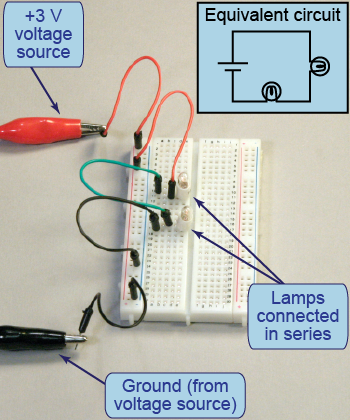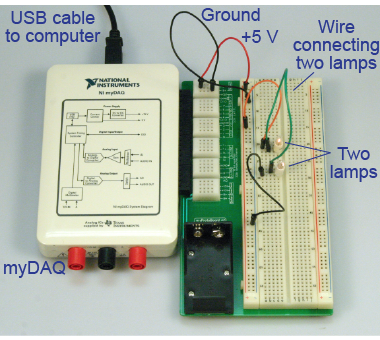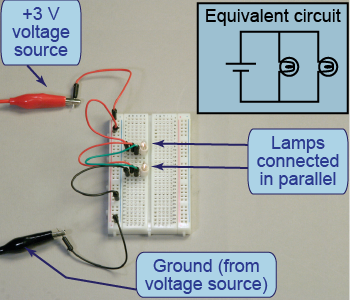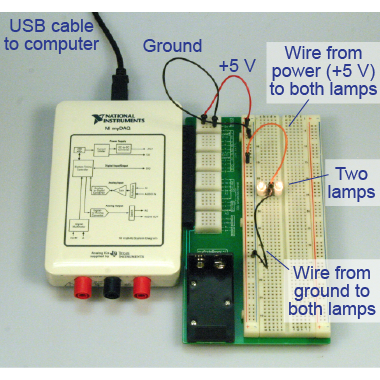|
| Essential questions | | What are the advantages and disadvantages of series versus
parallel circuits? | |
|
Have you ever had a string of holiday lights where one lamp is burned out, preventing all the other lamps from lighting? Was it easy to find the burned out lamp? This investigation explores series and parallel circuits by connecting lamps and observing their brightness. By comparing the two circuit types, you will learn why the wiring of some strings of lights allows one bad bulb to disconnect all the other bulbs. 
|
Part 1: Connecting lamps in series

- Connect a +3 V voltage source (or two D-cell batteries) to the breadboard.
- Insert the lamp socket into the breadboard to create a one-lamp circuit and observe its brightness.
- Create a circuit with two lamps in series (figure at right). Compare the brightness of the two lamps to the previous circuit with one lamp.
- What property makes this a series circuit?
- How bright are the lamps in series compared to the single lamp? Why?
- Remove one lamp from the series circuit. What happens to the other lamp? Why?

|
How to connect the series circuit using the myDAQ
 The circuit for Part 1 can be constructed using a myDAQ. Make the connections following the illustration at right. Then answer the questions above.
The circuit for Part 1 can be constructed using a myDAQ. Make the connections following the illustration at right. Then answer the questions above.
|
Part 2: Connecting lamps in parallel

- Create a circuit with two lamps in parallel.
- Compare the brightness of the lamps in this circuit to the prior circuit with two lamps in series.
- What property makes this a parallel circuit?
- How bright are the parallel lamps compared to the series lamps? Compared to the single lamp? Why?
- Remove one lamp from the parallel circuit. What happens to the brightness of the other lamp? Why?
- Is a series or parallel circuit better for connecting a string of lights? Why?
- Design a circuit of three lamps that combines series and parallel arrangements, and sketch the circuit diagram. Use a mathematical model to predict the relative bulb brightnesses. Build the circuit and test your predictions. Were you correct?

|
How to connect the parallel circuit using the myDAQ
 The circuit for Part 2 can be constructed using a myDAQ. Make the connections following the illustration at right. Then answer the questions above.
The circuit for Part 2 can be constructed using a myDAQ. Make the connections following the illustration at right. Then answer the questions above.
|

